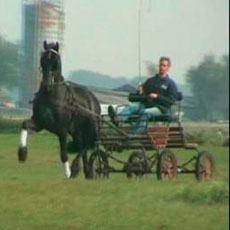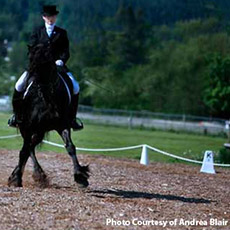About Friesian Horses
Friesians, one of the oldest breeds in Europe, are indigenous to what is now the Netherlands. Today, Friesian horse production is mainly limited to the province of Friesland, where they thrive in the meadow districts and in sandy soil areas.

Friesian Horses
The Friesian horse is unique. It developed from a very old breed which was inherent to all of Western Europe. It’s the only horse native to Holland. Historically speaking, the Friesian horse has been influenced by eastern bloodlines and has often been threatened with extinction.

FHANA is the North American representative of the original Friesian horse association, Friese Paarden Stamboek (FPS). The FPS is recognized as the European Mother Studbook of the Friesian Horse and is the world-wide authority on the Friesian Horse. FPS is the Netherlands’ oldest and second largest studbook and has about 15,000 members living in the Netherlands and abroad. At this time there are about 60,000 Friesian horses registered. The (Dutch) registry, Friesch Paarden-Stamboek (FPS), is much more highly regulated than United States-based horse registries. Most Friesian horses are graded at least twice in their lives and only a small number of stallions are approved for breeding.
Your Title Goes Here
Your content goes here. Edit or remove this text inline or in the module Content settings. You can also style every aspect of this content in the module Design settings and even apply custom CSS to this text in the module Advanced settings.
History of Friesian Horses
In the middle ages, it was mainly a knight’s horse, but in the 18th and 19th century the Friesian was especially famous as a trotting horse on short distances.
The Friesian was so adapted as a fast trotting coach horse that it was, in fact, Friesians who invented trotting races over short distances during the 18th century. This version was of little use in its principal form of work – on the farms – and its numbers declined drastically. At one time, the amount of registered Friesian Horses became even less than one thousand and the fate of the breed was uncertain.
Just before World War I it was close to extinction, but judicious crossing with Oldenburg lead to its revival. During World War II, because of petrol shortages and other factors, it came into its own again. It was honoured in 1954 when Queen Juliana of the Netherlands granted its Breed Society the right to preface its name with the word ‘Royal’.
Breeding is done under STRICT guidelines such as selection, performance testing and classification to ensure the quality of the breed remains VERY high. The “Friesch Paarden Stambook” (Friesian Horse Registry) dates back to 1879. Until 1943, both purebred and crossbred Friesian Horses were registered.
The Friesian horse is enjoying a revival. The Friesian is a noteworthy sight in the show ring with its shiny black coat, flying mane and tail, and high action form an imposing image. The Friesian is, by nature, a talented show horse.

Breed Characteristics
Friesian Horses are always black. White markings are not allowed on the body or legs. A small white forehead star is allowed. They have a long, thick, flowing mane and tail and pronounced fetlock hair. Under no circumstance is it permissible to dock the tail of a Friesian and, in fact, trimming of any hair from mane, tail or legs is frowned upon. The Friesian Horse holds it head high and proud with an arching neck.
Your Title Goes Here
Your content goes here. Edit or remove this text inline or in the module Content settings. You can also style every aspect of this content in the module Design settings and even apply custom CSS to this text in the module Advanced settings.
Breed Characteristics List
- The head is relatively short and the width is proportional to the length.
- The ears are small and alert with the tips pointing slightly toward each other.
- The eyes are large and shining.
- The nasal bone is slightly hollow or straight; nostrils are wide.
- The lips are closed and the teeth meet properly.
- The jaw bones are not heavy and are spread wide apart to allow the horse to breathe easily while at work.
- The head is set gracefully on the neck with adequate space for the throat. Overall, the head is dry and expressive and blends smoothly into the neck.
- The neck is lightly arched at the crest. It is long enough for the horse to bend properly and is adequately muscled. The neck is set on high and the lower neckline does not bulge between the throat and the chest. The neck is lightly arched at the crest. It is long enough for the horse to bend properly and is adequately muscled.
- The body is strong and deep with a sloping shoulder.
- The withers are well developed, prominent and, in particular, blend gradually into the back.
- The rear quarters are sloping with a somewhat low-set tail.
- The back is not too long and is well muscled. A slightly low back is allowed.
- The loin is wide, strong and well-muscled and makes a smooth transition into the croup.
- The croup is of good length and slopes slightly downward; it is wide and muscular. It neither forms a point nor is overly rounded.
- The tail is not set on too low.
- The gluteal muscle is long and well developed.
- The shoulders are long and sloping and are set widely enough apart to form a good chest, which is neither too wide nor too narrow.
- The ribs are long and curved, supplying ample space for the heart and lungs, without being rotund.
- The belly maintains sufficient depth towards the rear.
- The hind legs, viewed from the rear, are straight. Viewed from the side, the legs are set directly under the hind quarters and are strong with good, sound hoofs.
- The hind cannon is a little longer than in front. The cannon bone is not too long; the forearm, however, has good length.
- The gaskin is long, with well-developed muscle.
- The angle at the hock is approximately 150 degrees. Selective breeding is used to achieve the active hock action and high, extended leg action.
- The forelegs are properly positioned and when viewed from the front, are set parallel with a hoof width of space at the ground. Viewed from the side, they are perpendicular down through the fetlock joint.
- The pastern is resilient, of good length and is at a 45-degree angle to the ground.
- The hoofs are wide and sound.
- The joints in the legs are dry, well-developed, and provide a good foundation for the tendons and ligaments.
The overall appearance of the horse’s body is more nearly a rectangle than a square. When the shoulder is long and sloping, the back is not too long, and the croup is of adequate length, the ratio of fore-, middle- and hind-quarters can be an ideal 1:1:1. The horse is neither too massive nor too light.
The animated gait is natural. The walk is straight, vigorous and springy. There is good length of stride and the hind quarters swing forward with power.
The trot is a reaching and forward movement with power from the hind quarters. It is elevated and light-footed with a moment of suspension. The hock flexes as the horse moves forward and the inside angle of the hind leg closes during each stride.
The canter is well supported and lively with sufficient power from the hind quarters and flexion in the hock.
Driving one or more Friesian horses has become increasingly popular in the past few years. Tough international competitions are only for the few, but there are many who derive relaxation and pleasure from driving Friesians for recreation. The person who wants to perfect his driving and test his skill against others, can do so at the many dressage driving events.
The Friesian horse has a talent for dressage. The foundation lies in his intelligence, willingness to learn, and readiness to perform. His pleasant character and his gentleness make the Friesian an attractive mount for competition as well as for recreational purposes. The riding club “De Oorsprong” (the source), from Huis ter Heide near St. Nicolaasga in Friesland, has been using only Friesian horses since 1937 in order to advertise their abilities as riding horses.
Now the future of this ancient breed looks relatively favorable, but in order to maintain the integrity of the breed, it is important that the FPS rules, regulations and strict guidelines are respected.
FHANA is the North American representative of the original Friesian horse association, Friese Paarden Stamboek (FPS). The FPS is recognized as the European Mother Studbook of the Friesian Horse and is the world-wide authority on the Friesian Horse. FPS is the Netherlands’ oldest and second largest studbook and has about 12,000 members living in the Netherlands and abroad. At this time there are about 40,000 Friesian horses registered. The (Dutch) registry, Friesch Paarden-Stamboek (FPS), is much more highly regulated than United States-based horse registries. Most Friesian horses are graded at least twice in their lives and only a small number of stallions are approved for breeding.
In order to be approved for breeding, stallions must pass exacting examinations of pedigree, conformation, quality of gaits and movement, performance under saddle, performance as driving horses, and they must also demonstrate good temperament and trainability. Only a tiny percentage of FPS-registered stallions are deemed to have the qualities needed to improve the breed for future generations. This strict stallion selection by the Dutch Studbook is what makes Friesian horses continuously better and better, without losing the magical quality that attracts people to the breed.
Contact Us
Endymion Farms
KFPS Quality Friesian Horses
Email: info@endymionfarms.ca
Phone: 250-938-5045
P.O. Box 1254
Vernon, BC V1T 6N6
We accept the following credit cards: Visa and Mastercard.
